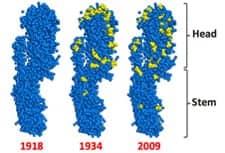Scientists have long known that some viruses and bacteria begin infections by latching first onto sugar molecules on the surfaces of cells lining the sinuses and throat of mammals, including humans. Viral particles, for instance, can attach to these molecules, called sialic acids, or SAs, like keys fitting into locks.
Now, a new study in infant mice shows that keeping virus particles from attaching to SAs limits not only just the entry of influenza A viral infections, but also hinders their exit (shedding) and transmission from mouse to mouse. Such infections are the main cause of the seasonal flu that kills more than 36,000 Americans annually. While vaccines to guard against infection and symptom treatments exist, they are not foolproof, scientists say, and more strategies are needed to prevent infection from spreading.
Led by researchers from NYU Grossman School of Medicine, the study team stripped away, or desialylated, SA receptors by placing directly into mouse nasal cavities a neuraminidase enzyme known to loosen the acids’ ability to remain attached to cell surfaces. The infant mice were then infected with influenza A. Results showed treatment with the neuraminidase enzyme dramatically cut mouse-to-mouse transmission rates by more than half (from 51% to 100% ) in a half-dozen influenza strains tested.
Published in the American Society for Microbiology journal mBio, the work was conducted in infant mice, which unlike those even a few months older or adult mice, were found by the research team to have many sialic acids in the upper portion of their respiratory tract.
Specifically, the team blocked two SAs, technically called alpha-2,3 SA and alpha-2,6 SA receptors (the locks). These are known to be widely present in the human respiratory tract, which researchers say makes infant mice a strong comparable model for studying the spread of the infectious disease in children, who are also recognized as important “drivers” of flu transmission among people.
“If further experiments in humans prove successful, desialylating neuraminidase enzymes may prevent the flu from spreading,” says lead study investigator and infectious disease specialist Mila Ortigoza, MD, PhD, in a release. “While current approaches with vaccines and treatments target the virus, ours is the first study to demonstrate that treating the host, either infected mice or potentially infected humans, to prevent them from transmitting the virus to another host could be another effective strategy for combating pervasive infectious diseases.”
Ortigoza cautions that extensive clinical research is needed before neuraminidases can be considered for approval as a treatment in humans. She says the team already has plans for more experiments to examine why infants are more susceptible to infection from respiratory viruses and whether blocking sialic acids in children can also prevent the spread of influenza.
Photo 39239908 © Brijith Vijayan | Dreamstime.com









